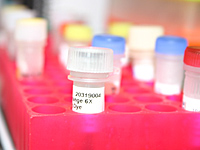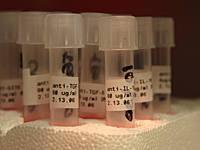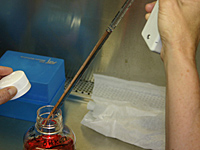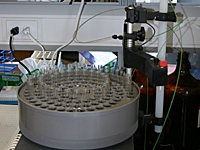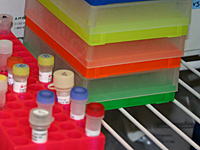Media Contact
John Welsh
jwelsh@vrisd.org
Adapted from a press release by the American Association for Cancer Research
New Tool Allows for Alternate Prostate Cancer Diagnosis
- Test conducted in the non-cancerous part of the prostate.
- May aid in localization of cancer lesion within the prostate gland.
SAN DIEGO — Researchers at the Vaccine Research Institute of San Diego (VRISD) and at University of California, Irvine, have found that it may not be necessary to look for tumors directly in patients with prostate cancer — analyzing non-tumor tissue may be an effective option, according to study results published in Cancer Research, a journal of the American Association for Cancer Research (http://cancerres.aacrjournals.org/content/71/7/2476.abstract).
One lead investigator, Michael McClelland, at VRISD, said "We found that a biopsy needle does not need to hit a tumor to detect the presence of tumor". He compared the strategy to the game Battleship; "We may be able to detect more cancer cases using 12 shots with a biopsy needle than would otherwise be the case because we have made the ships bigger."
The other co-lead researcher Dan Mercola, M.D., Ph.D., professor of pathology and laboratory medicine at the University of California at Irvine, noted that over 1 million prostate biopsies are performed in the United States each year, and these diagnostic tests can miss up to 30 percent of clinically significant prostate cancers. As many as one third of patients receive repeat biopsies within a year due to equivocal first results, Mercola said. Based on these study results, physicians could possibly detect changes in non-tumor tissue that indicate a tumor may be present, which could allow patients to be given a follow-up biopsy more quickly.
"Changes in the non-tumor tissue surrounding the tumor have long been considered to be important to tumor growth. Interfering with this process could have therapeutic value," Dr. Mercola said. "The information in non-tumor tissue indicating 'presence of tumor' or not indicates who needs urgent re-biopsy and allows patients to consider alternative therapies to surgery or radiation such as neoadjuvant therapy or prostate cancer prevention treatment."
Mercola, McClelland, and colleagues obtained 364 samples from men of all races who had biopsies for possible prostate cancer, or had prostatectomies to remove cancer, as well as control prostates from donors that had died of causes other than prostate cancer.
They observed changes in the nearby non-tumor tissue and found that changes in gene expression in normal tissue could be detected up to a few millimeters from prostate cancer.
"It is known that at least some prostate cancers cause a reaction in nearby stroma," Mercola said. "However, we were surprised that a reaction may occur for most tumors, and we are surprised this response in non-tumor tissue may extend for many millimeters from the tumor."
Ruoxiang Wang, M.D., Ph.D., research scientist II and associate professor in the department of medicine at Cedars-Sinai Medical Center, Los Angeles, and editorial board member for Cancer Research, said this study represents "one of the only few painstaking attempts to define the pathology of tumor-associated stroma in prostate cancer patients…this study is the first to use clinical specimens in such studies in large scale, while the findings are in such a high statistical significance."
"It is hoped that the large sample size and the high statistical significance of this study may help to ensure a better follow-up, and some of the defined stromal markers will eventually be validated with clinical values," she said.
Further studies will be required to confirm the findings, and before urologists will likely be able to use a diagnosis based on non-tumor tissue for recommending surgery or other radical treatment, according to the researchers. Wang added that these results, if confirmed, could provide guidance to the understanding of the tumor microenvironment, as cancer-stromal interaction plays a pivotal role in prostate cancer progression and bone metastasis.
Aspects of this work are undergoing commercialization at Althea DX and Proveri Corp.
We wish to acknowledge support from the National Cancer Institute and the Congressionally Directed Medical Research programs at the Department of Defense. We thank Mr. Sidney Kimmel and many other financial donors for their support. This work could not have been completed without the combined support of taxpayers and generous donors.
Home | About VRISD | News | Research | Publications
Careers At VRISD | How To Help | Contact Us
© VRISD 2006











